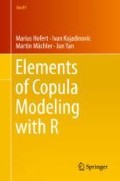Abstract
Assume that one is given the two bivariate data sets displayed in Fig. 1.1 and asked to compare them in terms of the “dependence” between the two underlying variables. The first (respectively, second) data set, denoted by (x i1, x i2), i ∈{1, …, n} (respectively, (y i1, y i2), i ∈{1, …, n}), is assumed to consist of n = 1000 independent observations (that is, a realization of independent copies) of a bivariate random vector (X 1, X 2) (respectively, (Y 1, Y 2)). Roughly speaking, comparing the two data sets in terms of dependence means comparing the way X 1 and X 2 are related with the way Y 1 and Y 2 are related.
Access this chapter
Tax calculation will be finalised at checkout
Purchases are for personal use only
References
Cherubini, U., Luciano, E., & Vecchiato, W. (2004). Copula methods in finance. Chichester: Wiley.
Cherubini, U., Mulinacci, S., Gobbi, F., & Romagnoli, S. (2011). Dynamic copula methods in finance. Chichester: Wiley.
Devroye, L. (1986). Non-uniform random variate generation. New York: Springer.
Durante, F., & Sempi, C. (2010). Copula theory: An introduction. In P. Jaworski, F. Durante, W. K. Härdle & W. Rychlik (Eds.), Copula theory and its applications (Warsaw, 2009). Lecture notes in statistics (pp. 3–32). Berlin: Springer.
Durante, F., & Sempi, C. (2015). Principles of copula theory. Boca Raton, FL: CRC Press.
Embrechts, P. (2009). Copulas: A personal view. Journal of Risk and Insurance, 76, 639–650.
Embrechts, P., & Hofert, M. (2013). A note on generalized inverses. Mathematical Methods of Operations Research, 77(3), 423–432.
Embrechts, P., McNeil, A. J., & Straumann, D. (2002). Correlation and dependency in risk management: Properties and pitfalls. In M. Dempster (Ed.), Risk Management: Value at Risk and Beyond (pp. 176–223). London: Cambridge University Press.
Genest, C., & Favre, A.-C. (2007). Everything you always wanted to know about copula modeling but were afraid to ask. Journal of Hydrological Engineering, 12, 347–368.
Genest, C., Gendron, M., & Bourdeau-Brien, M. (2009). The advent of copulas in finance, European Journal of Finance, 15, 609–618.
Genest, C., Rémillard, B., & Beaudoin, D. (2009). Goodness-of-fit tests for copulas: A review and a power study. Insurance: Mathematics and Economics, 44, 199–213.
Hoeffding, W. (1940). Massstabinvariante Korrelationstheorie, Schriften des mathematischen Seminars und des Instituts für Angewandte Mathematik der Universität Berlin, 5, 181–233.
Joe, H. (1997). Multivariate models and dependence concepts. London: Chapman & Hall.
Joe, H. (2014). Dependence modeling with copulas. Boca Raton, FL: Chapman & Hall/CRC.
Mai, J.-F., & Scherer, M. (2014). Financial engineering with copulas explained. London: Palgrave Macmillan.
McNeil, A. J., Frey, R., & Embrechts, P. (2015). Quantitative risk management: Concepts, techniques and tools (2nd ed.). Princeton, NJ: Princeton University Press.
Nelsen, R. B. (2006). An introduction to copulas. New York: Springer.
Patton, A. J. (2013). Copula methods for forecasting multivariate time series. In G. Elliott & A. Timmermann (Eds.), Handbook of economic forecasting (pp. 899–960). New York: Springer.
Rémillard, B. (2013). Statistical methods for financial engineering. Boca Baton, FL: Chapman & Hall/CRC.
Salvadori, G., De Michele, C., Kottegoda, N. T., & Rosso, R. (2007). Extremes in nature: An approach using copulas. Water science and technology library (Vol. 56). Berlin: Springer.
Author information
Authors and Affiliations
Rights and permissions
Copyright information
© 2018 Springer International Publishing AG, part of Springer Nature
About this chapter
Cite this chapter
Hofert, M., Kojadinovic, I., Mächler, M., Yan, J. (2018). Introduction. In: Elements of Copula Modeling with R. Use R!. Springer, Cham. https://doi.org/10.1007/978-3-319-89635-9_1
Download citation
DOI: https://doi.org/10.1007/978-3-319-89635-9_1
Published:
Publisher Name: Springer, Cham
Print ISBN: 978-3-319-89634-2
Online ISBN: 978-3-319-89635-9
eBook Packages: Mathematics and StatisticsMathematics and Statistics (R0)

